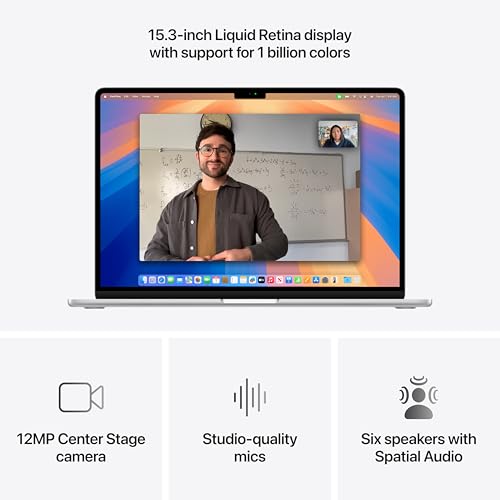The New Paradigm: An Exhaustive Technical Dissection of the 2025 MacBook Air with M4
Introduction: The Third Revolution of the Air
Since its dramatic unveiling from a manila envelope, the MacBook Air has served as the vanguard for the future of personal computing. It defined the ultrabook category, proving that a lightweight, impossibly thin design did not have to come at the expense of a full-featured, uncompromised user experience. Then, with the introduction of the M1 chip, Apple initiated the second revolution: it redefined the performance and efficiency expectations for the entire industry, delivering unprecedented power within the same silent, fanless chassis. Now, in 2025, we are witnessing the third, and perhaps most profound, revolution with the launch of the MacBook Air powered by the M4 chip. This machine is not merely an iterative update focused on faster clock speeds; it is the physical manifestation of Apple’s long-term vision for computing. It is a device built from the silicon up with a singular purpose: to deliver powerful, personal, and private artificial intelligence through a system Apple has dubbed “Apple Intelligence.”
This review is an exhaustive technical deep dive intended for the discerning general user, the student, the professional, and the creative who seeks to understand the fundamental engineering that powers this new experience. We will move far beyond marketing claims to explore the intricate architecture of the M4 System-on-a-Chip (SoC), dissecting its CPU, GPU, and, most critically, its significantly enhanced Neural Engine. We will demystify the concept of Apple’s Unified Memory Architecture and explain why 24GB of memory in this machine behaves differently from its counterparts in the PC world. A substantial portion of this analysis will be dedicated to Apple Intelligence itself—what it is, how it leverages the M4’s silicon for on-device processing to protect user privacy, and what its practical applications mean for day-to-day productivity and creativity. We will also perform a granular analysis of the 15.3-inch Liquid Retina display, the advanced audio-visual suite, the expanded connectivity options, and the deep, almost magical, integration with the broader Apple ecosystem. This is the story of a laptop that is not just faster, but fundamentally smarter. For anyone considering an investment in a new portable computer, understanding the technology within the M4 MacBook Air is essential to understanding the direction of the entire industry.

Part I: The M4 System-on-a-Chip (SoC) – A Deep Architectural Dive
The M4 chip is not just a component within the MacBook Air; it is the MacBook Air. Every function, every pixel, and every operation flows through this single piece of silicon. Understanding its architecture is paramount to understanding the laptop’s capabilities.
-
The SoC Paradigm: A Foundation of Efficiency
Before diving into the M4’s specifics, it’s crucial to grasp the System-on-a-Chip (SoC) concept that Apple has perfected. In a traditional PC, the processor (CPU), graphics card (GPU), system memory (RAM), and other controllers are all separate components on a motherboard, connected by buses. Data must physically travel between these disparate parts, creating latency and consuming power. An SoC, by contrast, integrates all of these core components—CPU, GPU, Neural Engine, memory controllers, security processors, and more—onto a single, unified chip. This proximity allows for incredibly high-speed, low-latency communication between components and is the primary reason Apple Silicon can deliver such a remarkable combination of performance and power efficiency. The M4 chip represents the latest refinement of this philosophy, built on a cutting-edge manufacturing process that allows for an even greater density of transistors, leading to both higher performance and lower energy consumption than its predecessors.
-
The CPU Core Complex: Balancing Power and Efficiency
The central processing unit (CPU) within the M4 continues Apple’s hybrid architectural approach, featuring a cluster of high-performance cores (P-cores) and a cluster of high-efficiency cores (E-cores). The P-cores are designed for raw, single-threaded speed. They feature wide instruction decoders, large caches, and are clocked at very high frequencies to tear through demanding tasks like compiling code, applying complex filters in photo editing apps, or running physics in a game. The E-cores, while physically smaller and clocked lower, are designed for maximum efficiency. They handle the vast majority of background tasks, system processes, and less-demanding applications, consuming a fraction of the power of the P-cores. The magic lies in how macOS intelligently and seamlessly assigns tasks to the appropriate cores. This hardware-software integration ensures that when you’re browsing the web or watching a video, the E-cores are doing the work to maximize battery life. But the moment you launch a demanding application, the P-cores fire up instantly to provide maximum performance. The M4 chip features enhanced versions of both core types, offering higher Instructions Per Clock (IPC) and improved power curves, resulting in a system that is both faster and longer-lasting.
-
The Neural Engine: The On-Device AI Powerhouse
The most significant evolution in the M4 is arguably its vastly more powerful Neural Engine (NPE). The NPE is a highly specialized processor designed for one purpose: to execute machine learning (ML) and artificial intelligence (AI) models at incredible speed with minimal power draw. While a CPU or GPU can also run these models, they are general-purpose processors and are far less efficient at the specific types of matrix multiplication and vector math that form the bedrock of AI. The M4’s Neural Engine is capable of performing trillions of operations per second (TOPS), and it’s this raw power that enables the entire Apple Intelligence system to run primarily on-device. This on-device processing is the cornerstone of Apple’s AI strategy. It means that when you use AI to summarize a document, generate an image, or transcribe a meeting, the computation is happening locally on your MacBook Air. This is fundamentally faster, as it eliminates the need for a round-trip to a cloud server, and it is fundamentally more private, as your personal data never has to leave your device for processing.
-
Unified Memory Architecture (UMA): The Secret Sauce
One of the most misunderstood yet critical aspects of Apple Silicon is its Unified Memory Architecture. In a traditional PC, the CPU uses system RAM, while the GPU has its own dedicated, high-speed pool of video memory (VRAM). When the CPU needs the GPU to work on some data (like a texture for a game), it must copy that data from the RAM over a bus to the VRAM. This copying process introduces latency and is inefficient. Apple’s UMA creates a single, unified pool of high-bandwidth, low-latency memory that is directly accessible by the CPU, GPU, and Neural Engine simultaneously. Think of it like a master artisan’s workbench where all tools (CPU, GPU, NPE) and all materials (data) are within immediate reach, rather than in separate rooms. This architecture eliminates the need for redundant data copies, dramatically reducing latency and improving both performance and efficiency. It’s why the 24GB of unified memory in this MacBook Air can feel more responsive and capable than a PC with a higher-but-separate amount of RAM and VRAM, especially in creative tasks that heavily utilize both the CPU and GPU.

Part II: Apple Intelligence – Software and Silicon in Harmony
Apple Intelligence is not an app; it is a pervasive, system-wide intelligence layer that deeply integrates with macOS and leverages the power of the M4 chip. It’s designed to be helpful, personal, and, above all, private.
-
A Hybrid Model: On-Device Speed and Private Cloud Compute
Apple’s approach to AI is a sophisticated hybrid model. The M4’s powerful Neural Engine is the first line of processing. The vast majority of AI tasks—summarizing text, proofreading an email, creating a Genmoji, organizing photos—are handled entirely on-device. This is possible because Apple has developed highly optimized models that can run efficiently on its own silicon. This on-device-first approach provides near-instantaneous responses and ensures your personal data remains secure. However, for more complex queries that require larger, more powerful models (for example, generating a highly detailed, complex image from a very long prompt), Apple Intelligence can seamlessly hand off the request to “Private Cloud Compute.” This is not a generic cloud service. Apple has built dedicated servers running on Apple Silicon, and they’ve engineered a system where your data is sent cryptographically secured, is never stored, and is not accessible by Apple, ensuring your privacy is maintained even when using the cloud.
-
Practical Applications in Daily Workflows
For the general user, Apple Intelligence manifests as a suite of powerful, intuitive tools integrated directly into the apps they use every day. The **Writing Tools** are a prime example. System-wide, you can select any text and ask Apple Intelligence to proofread it, change its tone to be more professional or friendly, or summarize it into key points. This is incredibly useful for everything from drafting important work emails to condensing long articles for research. **Image Playground** allows you to create fun, generative images in seconds, directly within apps like Messages or Notes. The system is also deeply integrated into **Siri**, making it far more capable. Siri can now understand personal context on your device, allowing you to make requests like “Pull up the photos I took at the beach last week” or “Summarize the email I just received from John.” It can also take actions within and across apps, fundamentally transforming Siri from a simple voice assistant into a powerful productivity tool. All of this happens effortlessly, with the M4 chip’s Neural Engine handling the heavy lifting silently in the background.

Part III: The Sensory and Physical Experience
Beyond the silicon, the MacBook Air’s design and physical components are engineered to an exacting standard, creating a cohesive and premium user experience.
-
The 15.3-inch Liquid Retina Display: A Window to Your Work
The display is a user’s primary interface, and the Liquid Retina panel on the M4 MacBook Air is a masterpiece of display engineering. The term “Liquid Retina” refers to its high pixel density, which is so fine that individual pixels are indistinguishable at a normal viewing distance, making text appear as crisp as printed text in a book. The panel’s ability to display **1 billion colors** is a result of its true 10-bit color depth, which allows for exceptionally smooth gradients and avoids the “banding” seen on lesser 8-bit displays. It supports the P3 wide color gamut, an industry standard in digital cinema, meaning it can reproduce a broader and more vibrant range of reds and greens than a standard sRGB display. This makes photos and videos pop with rich, lifelike color. The display also features Apple’s True Tone technology, which uses an ambient light sensor to automatically adjust the screen’s white point to match the lighting of your environment, reducing eye strain and making the image appear more natural.
-
Advanced Audio-Visual Suite for a Connected World
In an era of remote work and constant video communication, the quality of a laptop’s camera and microphone is paramount. The MacBook Air features a **12MP Center Stage camera**. The high-resolution sensor provides a sharp, detailed image, but the real innovation is Center Stage. This feature uses the camera’s wide-angle lens in conjunction with the M4’s Neural Engine to perform real-time AI-powered video processing. It automatically pans and zooms to keep you perfectly framed as you move around, and can even widen the frame when someone else joins you. The **three-mic array** uses advanced beamforming algorithms to capture your voice with clarity while actively filtering out background noise. The audio output is equally impressive. The **six-speaker sound system**, including force-cancelling woofers for surprisingly deep bass, supports **Spatial Audio with Dolby Atmos**. This technology creates a three-dimensional soundscape that makes it feel like sound is coming from all around you, providing an incredibly immersive experience for movies and music.
-
Silent Operation, Robust Build, and Modern Connectivity
Perhaps the most remarkable engineering feat of the MacBook Air is its completely **fanless design**. This is made possible by the incredible power efficiency of the M4 chip. Even under sustained load, the chip generates so little waste heat that it can be cooled passively through its aluminum chassis. This means the device is always completely silent, a huge benefit when working in quiet environments. The laptop is housed in a durable, unibody enclosure made from recycled aluminum. Connectivity is thoroughly modern, featuring two versatile **Thunderbolt 4 ports**, which provide 40Gbps of bandwidth for connecting high-speed external SSDs, docks, and high-resolution displays. A significant upgrade with the M4 is support for up to **two external displays** with the lid closed. The return of the **MagSafe 3** charging port is a welcome one, providing a secure magnetic connection that safely detaches if the cord is tripped over. Wireless connectivity is handled by **Wi-Fi 6E**, which adds support for the 6 GHz band for faster speeds and reduced interference, and **Bluetooth 5.3** for reliable connections to peripherals.

Part IV: The Ecosystem and Software Advantage
A Mac’s true power is often found not just in its hardware, but in its seamless integration with its software and other Apple devices.
-
macOS: Optimized for Apple Silicon
macOS is built from the ground up to take full advantage of Apple Silicon. All of Apple’s own apps, and a vast and growing library of third-party applications, run natively on the M4’s architecture, delivering incredible speed and responsiveness. For any older applications designed for Intel processors, Apple’s Rosetta 2 translation technology works seamlessly and transparently in the background, often with performance that rivals running on native Intel hardware. From professional suites like Adobe Creative Cloud to productivity platforms like Microsoft 365 and Google Workspace, the software ecosystem is robust, mature, and fully optimized for the hardware.
-
Continuity: The Magic of the Ecosystem
For users who own an iPhone or iPad, the Mac offers a level of integration that is unmatched. This suite of features, collectively known as Continuity, allows your devices to work together as one. With the new **iPhone Mirroring** feature, you can view and fully control your iPhone’s screen directly on your Mac, dragging and dropping files and responding to notifications without ever touching your phone. Universal Clipboard lets you copy text or an image on your iPhone and paste it directly on your Mac. You can answer FaceTime calls or send and receive SMS/MMS messages from your Mac via your iPhone’s cellular connection. These features are not gimmicks; they are powerful productivity enhancers that create a fluid, intuitive workflow that is a major reason many users choose to stay within the Apple ecosystem.
Pros
- Phenomenal Performance and Efficiency: The M4 chip delivers an industry-leading combination of raw speed and power efficiency, enabling desktop-class performance in a silent, fanless design.
- Deeply Integrated and Private AI: Apple Intelligence, powered by the M4’s Neural Engine, provides powerful on-device AI capabilities without compromising user privacy.
- Best-in-Class Battery Life: The efficiency of the M4 chip allows for up to 18 hours of use on a single charge, a benchmark that few competitors can match.
- Completely Silent Operation: The fanless design means the device is always perfectly quiet, regardless of the workload.
- Vibrant and Color-Accurate Display: The 15.3-inch Liquid Retina display is bright, sharp, and offers a wide color gamut, making it excellent for both creative work and media consumption.
- Seamless and Powerful Ecosystem Integration: Continuity features like iPhone Mirroring create an unmatched, fluid workflow for users of other Apple devices.
- Premium Build and AV Suite: A durable aluminum unibody, a high-resolution camera, and an immersive six-speaker sound system round out the premium experience.
Cons
- Premium Price Point: Configurations with higher memory and storage, like this 24GB model, come at a significant price premium.
- Limited Port Selection: While powerful, the two Thunderbolt ports may require a dongle or dock for users needing to connect multiple legacy peripherals.
- Non-Upgradeable Hardware: The unified memory and SSD are soldered to the logic board, meaning they cannot be upgraded after purchase. The configuration you buy is the one you will have for the life of the device.
- 60Hz Refresh Rate Display: The display is limited to a standard 60Hz refresh rate, lacking the fluidity of the 120Hz ProMotion displays found on Apple’s Pro models.
Conclusion
The 2025 MacBook Air with the M4 chip is a landmark device. It solidifies the MacBook Air not just as the best consumer laptop on the market, but as the blueprint for the future of personal computing. The narrative is no longer solely about raw gigahertz and benchmarks; it’s about intelligent, efficient, and deeply integrated performance. The M4 chip’s architecture, with its powerful Neural Engine, provides the foundation for Apple Intelligence, a system that promises to redefine productivity and creativity in a way that is both powerful and profoundly private. This raw power is housed in a chassis that remains impossibly thin, light, and completely silent, all while delivering a battery life that lasts all day and then some. From its stunning Liquid Retina display to its seamless integration with the Apple ecosystem, every aspect of the device feels polished, purposeful, and cohesive. While the price for high-spec models is significant and the lack of upgradability requires careful consideration at the time of purchase, the value proposition is undeniable. For the student, the professional, the writer, or the everyday user who wants a device that is powerful, reliable, secure, and ready for the next decade of AI-driven software, the M4 MacBook Air is not just the best choice; it’s the definitive one.







